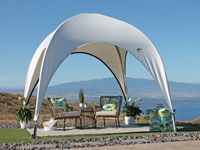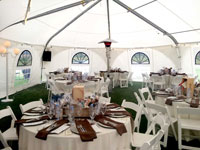During the warm, summer months, the knowledge that colder weather is just around the corner is looming. Whether you prefer to spend your summer days in your boat on the lake, racing trails on your ATV, or on camping trips in your recreational vehicle (RV), if you want to maintain the condition of your favorite toys, you need to have a plan ready to last the winter.
RVs, cars, and boats could wear down faster in the cold weather, and leaving them unprotected during the fall and winter could mean major damage. Aside from protecting your vehicles from snow, rain, wind, and foliage that could take time to clean up, you also need to worry about cooling temperatures. Water freezes, and if your vehicle has water stored in it, it could also be at risk of freezing damage.
Preparing now means you’ll have time to do your research, sort through the options, and find what works best for you. When winter does come, you’ll be ready and have the perfect place to store your vehicles!
What You’re Up Against
No matter what type of weather the future brings, you should be knowledgeable about what you’re up against so you can actively protect your vehicles.
Sunlight
Sunlight exposure cracks, chips, bubbles, and peels your paint job. This is especially problematic during the winter, when snow reflects the sunlight and, consequently, causes even more harm. While waxing can help mitigate the damage, it won’t prevent it.
The darker the color of your boat, RV, or ATV, the faster the degradation will be, but all colors will eventually fade with continued exposure to the sun. The same goes for the plastic surfaces, such as bumpers and mirror covers.
Rain and Moisture
Rain promotes rust. Although this does not happen overnight, simply being in a damp environment contributes to oxidation. Rust damage to your ATV, boat, or RV is just as serious as it is to your car, and you should treat it as such.
Snow
Many RVs are built with extraordinarily lightweight material. Often, the roofing material is so thin that to safely walk on the roof, you need to lay down plywood to redistribute the weight, preventing damage to the sheeting underneath the rubber membrane.
Just one foot of snow piled up on your RV could be enough to crush the sheeting.
Making matters worse, once the snow begins to melt, you have to deal with a humid environment that promotes rust.
Potential issues don’t end with snow melting and running down the drainpipe, though. The spring melting and refreezing cycle allows water to creep into every crack, and then tear those cracks open when the water expands upon refreezing. This freeze-thaw cycle turns small cracks and tears into big problems.
Traditional Equipment Storage Facilities Fall Short
While all construction methods naturally lend themselves to specific uses, traditional vehicle and equipment storage options have a number of glaring weaknesses in comparison with fabric structures engineered to provide protection against freezing temperatures, wind, rain, and snow.
Pole Barns for RV Storage
Pole barn construction permits often dictate how wide or tall your building can be. While you may legally be able to build a pole barn large enough to house your RV, adding space in the future for a jet ski or a pair of ATVs may necessitate building an entirely new building for everything to fit. That is if the county doesn’t allow lean-to-buildings to be added to the side of your existing pole barn.
While a craftsman builder can accomplish the opposite effect, for the most part, when lean-to-structures are added to an existing pole barn, the building’s aesthetics usually tell the truth of being a pieced together building solution with very little forethought to accommodate long-term storage plans.
Steel Building Garages
Steel construction is the least flexible of all options.
If an on-site adjustment is necessary, you won’t be able to easily make it. Measurements for construction need to be precise. Steel buildings also require you to pour a strong foundation and have the longest construction time of all options. Metal buildings are also great conductors of heat.
If you plan to keep your RV, boat, or ATVs above freezing, you will need to add expensive insulation to provide a required R-value for any assurance of maintaining a constant temperature during a cold snap.
Wood Buildings
While wood is one of the most popular materials for home construction and standalone garages for storing vehicles and other equipment, it has some significant drawbacks.
Drawbacks include a susceptibility to termites, water damage, fire, and decay. Wood also shrinks and swells with the weather, causing the structure to gradually weaken over time. This increases the possibility of collapsing under heavy snow loads or high winds as the building ages.
Most wood buildings are considered permanent structures by municipalities and building codes, requiring a permit to construct and build. This process can be both timely and expensive.
Traditional Garages and Vehicle Storage Facilities’ Common Shortcoming
All of these materials share one additional weakness: they are permanent. Unlike the relocatable vehicle and WeatherPort® equipment storage buildings from Alaska Structures®, once you pour the concrete or build your wooden shed, it’s there to stay.
No other building system gives you the ability to quickly set up your garage structure or equipment storage facility, use it year-round, or seasonally, and then easily take it down for either moving to a new location or for storing until next fall and winter arrive.
Garage and equipment storage structures from WeatherPort are lightweight, and depending on the model, size, and configuration, can be set up in as little as 15 to 20 minutes. The quality and craftsmanship that goes into making each fabric structure offers an unrivaled level of quality and durability and creates a building solution that is functional for both seasonal and year-round use.
Vehicle and Equipment Storage Facilities Made Using Engineered Fabric Structures
When it comes to fabric structures, there are many options to choose from. But few companies custom-design and engineer their portable building systems to meet local and international building codes for safety.
WeatherPort uses the highest-quality materials, a dedicated and hardworking team, strict quality control processes, and lean manufacturing techniques to create engineered fabric buildings that are truly one-of-a-kind.
The high-strength frame systems are constructed with either lightweight aircraft-grade aluminum or high-strength galvanized steel frame systems. Optional powder coating is available for storage facilities located in locations with high humidity or near coastal environments with corrosive sea spray.
The long-lasting fabric membranes are made using a proprietary blend of materials to create a tensioned fabric building that offers a greater abrasion resistance, is UV-stabilized (not coated) for superior protection from high solar loads, will not rot, is mold- and mildew-resistant, and exceeds the fire safety requirements outlined in the California Code of Regulations for membrane structures.
All engineered fabric buildings from WeatherPort can be securely anchored to nearly any type of surface and are virtually maintenance-free after being installed.
Contact Us Today to Custom-Build A Storage Facility!
When it comes to protecting your car, RV, ATV, dirt bike, water craft, or any other toy that you can’t bring indoors, WeatherPort’s engineered fabric structures create the perfect storage facilities for keeping all of your outdoor equipment safe this and future winters.
While store-bought sheds provide upfront savings at the register, they quickly deteriorate in high winds and prolonged UV exposure, and are not engineered to protect expensive and valuable equipment from collapses when subjected to heavy snows.
When the snow begins to pile up, or the wind blows a bit harder than usual, you’ll soon have a tattered shed and a lot of damaged equipment. You’ll then wish you had made the investment in a quality and engineered fabric structure from WeatherPort!
If you already have a clear idea of what you need, explore our fabric carports and vehicle storage solutions to get started right away. If you’d prefer personalized guidance, our team of experienced building specialists are ready to assist you in choosing from a number of building models and customizing nearly every aspect of your equipment storage facility to meet your immediate and ongoing storage needs.
For more information, please call +1-970-399-5909 for immediate assistance.
WeatherPort® is a brand of high-quality fabric buildings from Alaska Structures®. If you wish to submit your project details and have a building specialist contact you, please complete our online form or send an email to info@weatherport.com.

















































































Leave a Reply